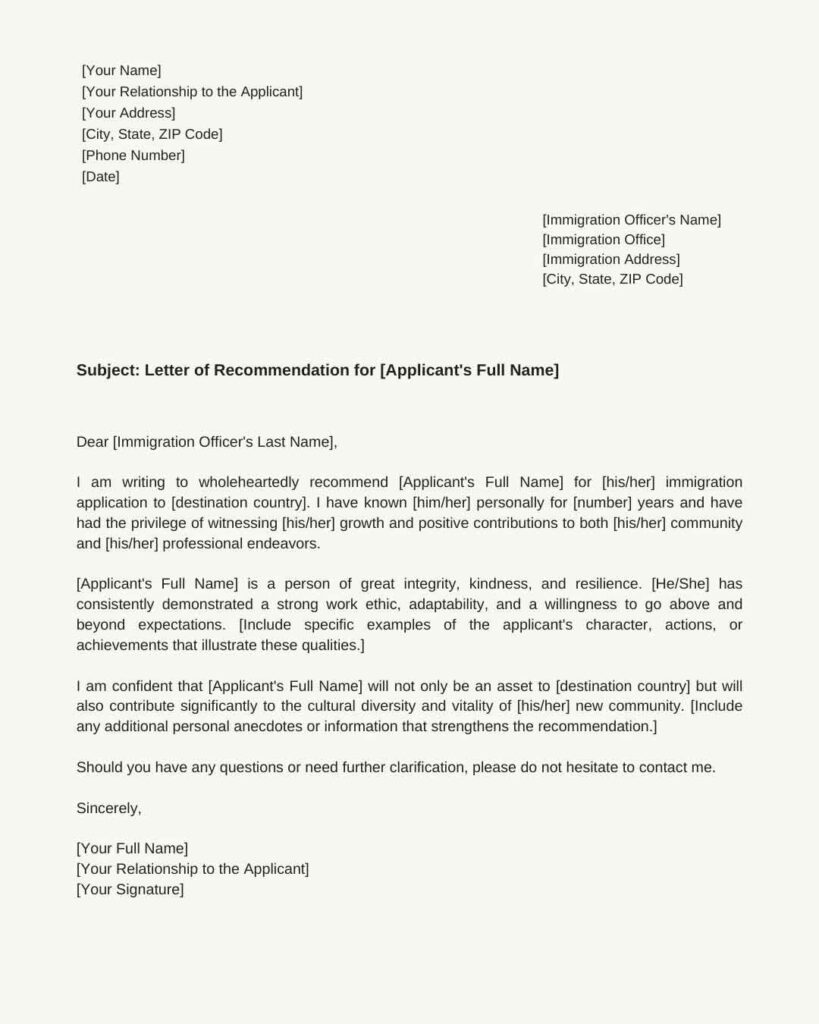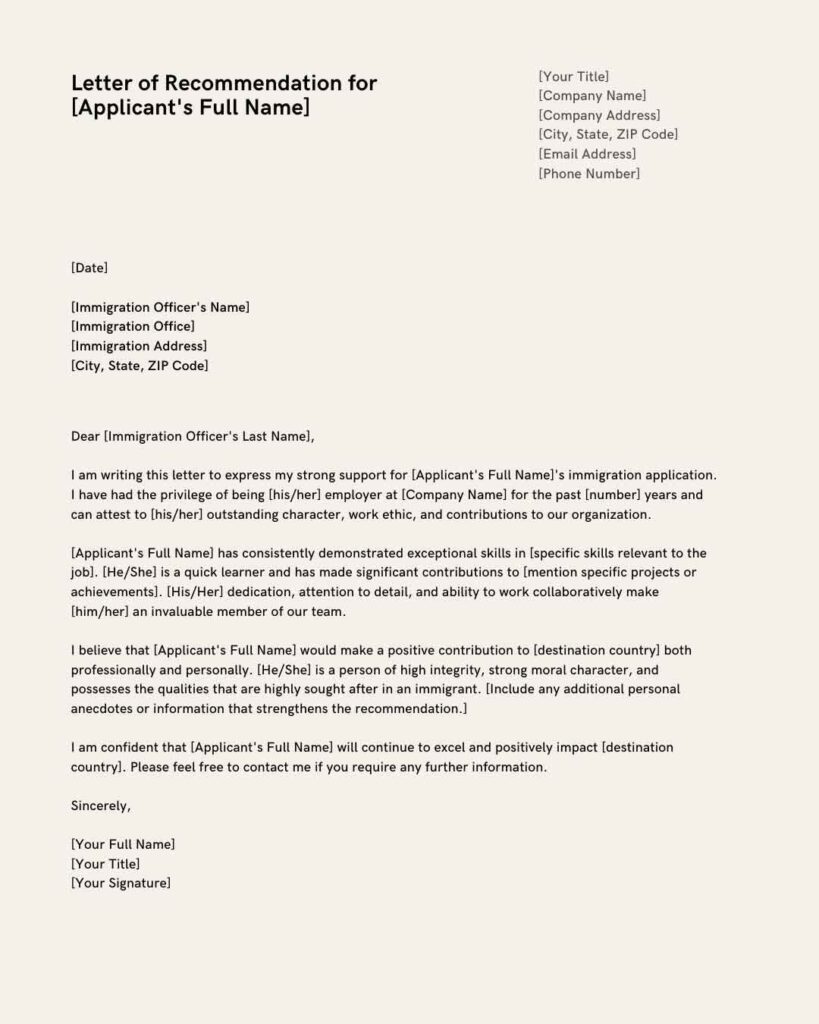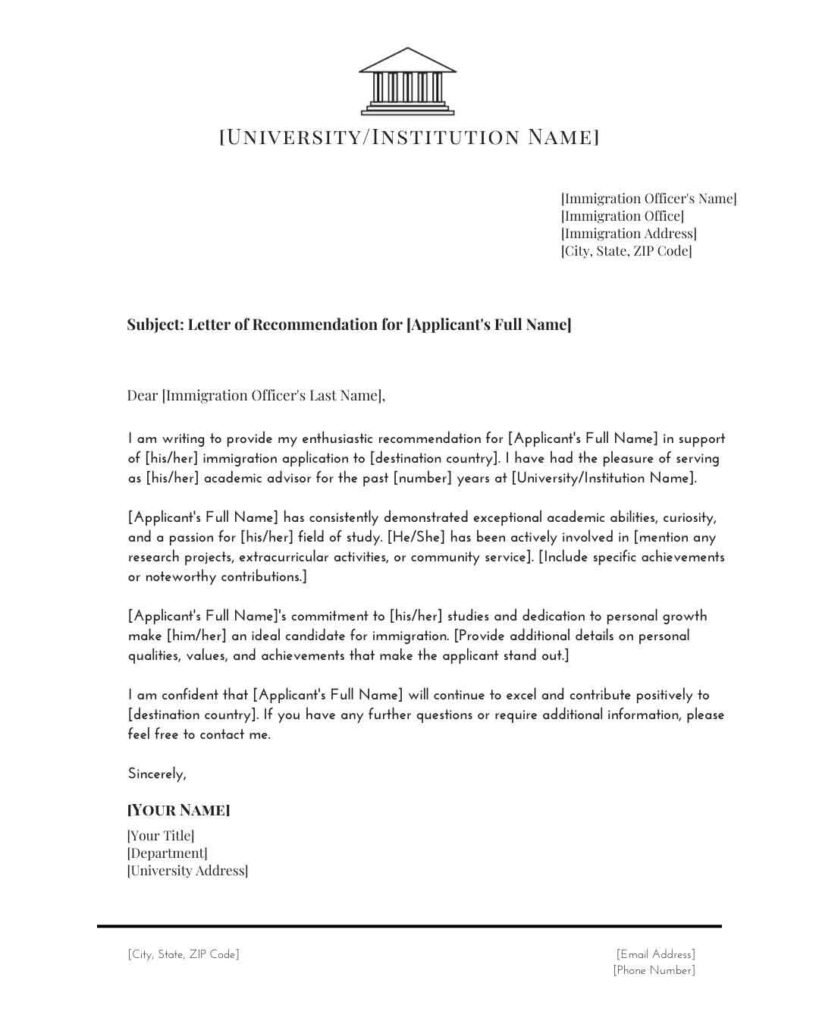In the intricate process of immigration, where every document plays a pivotal role in shaping the applicant’s fate, one piece stands out that can influence the decision– the immigration letter of recommendation.
This document acts as a bridge between your experiences, qualifications, and the eyes of immigration authorities. It goes beyond the formality of paperwork, becoming a personalized testament to your character and potential contributions in your new community.
What is an Immigration Letter of Recommendation:
An Immigration Letter of Recommendation is a personalized document written by an individual, often someone familiar with the applicant’s professional or personal life, to support an immigration application.
It serves as a testimonial, highlighting the applicant’s character, qualifications, achievements, and suitability for immigration. This letter goes beyond standard documentation, providing immigration authorities with insights into the applicant’s unique attributes, contributing to a more comprehensive evaluation of their profile.
Why an Immigration Letter of Recommendation Matters:
While it may seem like just another requirement, this letter serves as your advocate. It transforms your immigration application from a set of documents into a narrative that speaks volumes about who you are, your strengths, and the unique qualities you bring to the table.
It’s crucial to understand that this piece of writing is not just a box to check but a powerful document that can influence your journey toward a new chapter in your life.
I. Understanding the Purpose of an Immigration Letter of Recommendation:
An immigration letter of recommendation serves as a key element in the applicant’s immigration dossier, offering a unique perspective on their character, capabilities, and potential contributions to the community. Here, some core purposes that this letter fulfills:
Vouching for Character:
The recommendation letter provides a firsthand account of the applicant’s character, emphasizing qualities such as integrity, responsibility, and ethical conduct.
Highlighting Achievements:
It serves as a way to showcase the individual’s professional and personal achievements, shedding light on their skills, accomplishments, and unique attributes.
Demonstrating Cultural Fit:
By detailing the applicant’s ability to adapt to diverse environments and respect cultural nuances, the letter illustrates their potential to seamlessly integrate into the new community.
Affirming Support and Endorsement:
Perhaps most importantly, the letter is a formal expression of the recommender’s support for the applicant’s immigration journey, acting as a powerful endorsement that can significantly impact the decision-making process.
Understanding these key purposes is foundational to crafting a compelling immigration letter of recommendation that goes beyond a mere formality, becoming a persuasive advocate for the applicant’s approval.
II. Key Components of an Effective Immigration Letter of Recommendation:
Crafting a persuasive immigration letter of recommendation involves incorporating several crucial components that collectively contribute to its impact. To ensure its effectiveness, consider the following key elements:
1. Introduction:
Begin with a captivating introduction that briefly introduces the recommender, their relationship with the applicant, and the purpose of the letter. This section sets the tone for the entire document.
2. Recommender’s Credentials:
Detail the recommender’s qualifications, experience, and expertise. Emphasize why their opinion is valuable and credible, establishing a foundation for the reader to trust the insights provided.
3. Relationship with the Applicant:
Clearly articulate the nature of the relationship between the recommender and the applicant. Whether professional, academic, or personal, this section adds context to the recommender’s observations.
4. Specific Examples and Achievements:
Provide specific instances where the applicant demonstrated commendable qualities. These examples should substantiate the recommender’s positive assertions about the applicant’s character and capabilities.
5. Emphasis on Character:
Devote a section to discuss the applicant’s character traits, emphasizing qualities like honesty, responsibility, and integrity. Offer anecdotes or situations that highlight these attributes.
6. Positive Language and Tone:
Maintain a positive and supportive tone throughout the letter. Employ language that underscores the applicant’s strengths without unnecessary embellishments.
7. Cultural Adaptability and Diversity Appreciation:**
Discuss the applicant’s ability to adapt to diverse environments and appreciate different cultures. Highlight experiences that demonstrate their openness and respect for diversity.
8. Conclusion and Endorsement:
Summarize the key points and conclude the letter with a robust endorsement of the applicant. Express confidence in their potential contributions to the new community.
By incorporating these essential components into the immigration letter of recommendation, you create a comprehensive and impactful document that enhances the applicant’s chances of success.
Also Read: The Ultimate Guide to Immigration: From Dream to Reality
III. Structuring the Immigration Letter of Recommendation:
A well-structured immigration letter of recommendation not only enhances readability but also ensures that the content is presented in a logical and persuasive manner. Follow these guidelines to structure the letter effectively:
1. Clear and Concise Introduction:
Begin with a concise introduction that clearly states the purpose of the letter and introduces the recommender. Avoid unnecessary details in this section to maintain brevity.
2. Thematic Paragraphs:
Organize the body of the letter into thematic paragraphs, each addressing a specific aspect of the applicant’s qualities or achievements. This structured approach aids comprehension and highlights key points.
3. Chronological Order (if applicable):
If discussing the applicant’s achievements or experiences over time, consider presenting information in chronological order. This can provide a natural flow to the narrative.
4. Use of Subheadings (optional):
If the letter covers various aspects such as professional achievements, personal qualities, and community involvement, consider using subheadings for clarity. Subheadings help break down the content into digestible sections.
5. Transition Sentences:
Ensure smooth transitions between paragraphs by incorporating sentences that connect ideas and maintain a cohesive flow. This prevents the letter from feeling disjointed.
6. Highlighting Key Achievements:
Use bullet points or bold text to highlight key achievements or characteristics. This draws attention to crucial information and makes it easier for the reader to identify significant points.
7. Personalization and Specificity:
Personalize the letter by including specific details about the applicant. Whether it’s a unique accomplishment, a memorable interaction, or a standout quality, specificity adds depth to the recommendation.
8. Logical Progression:
Maintain a logical progression of ideas throughout the letter. Start with introductory information, delve into specific details, and conclude with a strong endorsement. This ensures a cohesive narrative.
9. Addressing Potential Concerns (if applicable):
If there are any aspects of the applicant’s background that may raise concerns, address them tactfully within the letter. Use this opportunity to provide context or offer reassurance.
10. Concluding on a Positive Note:
End the letter on a positive and encouraging note. Reiterate the recommender’s confidence in the applicant’s abilities and emphasize the overall positive impression they leave.
By structuring the immigration letter of recommendation thoughtfully, you not only enhance its visual appeal but also guide the reader through a well-organized and compelling narrative.
IV. 3 Immigration Letter of Recommendation Templates:
Here are three different Immigration Letter of Recommendation examples for various situations:
You can copy the text of the templates below the images.
1. Immigration Letter of Recommendation Template 1: Personal Recommendation

Text Template:
[YourName]
[Relationship to the Applicant]
[Your Address]
[City, State, ZIP Code]
[Email Address]
[Phone Number]
[Date]
——-
[Immigration Officer’s Name]
[Their Office]
[Address]
[City, State, ZIP Code]
Subject: Letter of Recommendation for [Applicant’s Full Name]
Dear [Immigration Officer’s Last Name],
I am writing to wholeheartedly recommend [Applicant’s Full Name] for [his/her] immigration application to [destination country]. I have known [him/her] personally for [number] years and have had the privilege of witnessing [his/her] growth and positive contributions to both [his/her] community and [his/her] professional endeavors.
[Applicant’s Full Name] is a person of great integrity, kindness, and resilience. [He/She] has consistently demonstrated a strong work ethic, adaptability, and a willingness to go above and beyond expectations. [Include specific examples of the applicant’s character, actions, or achievements that illustrate these qualities.]
I am confident that [Applicant’s Full Name] will not only be an asset to [destination country] but will also contribute significantly to the cultural diversity and vitality of [his/her] new community. [Include any additional personal anecdotes or information that strengthens the recommendation.]
Should you have any questions or need further clarification, please do not hesitate to contact me.
Sincerely,
[Full Name]
[Relationship to the Applicant]
[Signature]
2. Immigration Letter of Recommendation Template 2: Employer’s Recommendation

Text Template:
[Your Name]
[Title]
[Company Name]
[Company Address]
[City, State, ZIP Code]
[Email Address]
[Phone Number]
[Date]
——
[Immigration Officer’s Name]
Office]
[Their Address]
[City, State, ZIP Code]
Subject: Letter of Recommendation for [Applicant’s Full Name]
Dear [Immigration Officer’s Last Name],
I am writing this letter to express my strong support for [Applicant’s Full Name]’s immigration application. I have had the privilege of being [his/her] employer at [Company Name] for the past [number] years and can attest to [his/her] outstanding character, work ethic, and contributions to our organization.
[Applicant’s Full Name] has consistently demonstrated exceptional skills in [specific skills relevant to the job]. [He/She] is a quick learner and has made significant contributions to [mention specific projects or achievements]. [His/Her] dedication, attention to detail, and ability to work collaboratively make [him/her] an invaluable member of our team.
I believe that [Applicant’s Full Name] would make a positive contribution to [destination country] both professionally and personally. [He/She] is a person of high integrity, strong moral character, and possesses the qualities that are highly sought after in an immigrant. [Include any additional personal anecdotes or information that strengthens the recommendation.]
I am confident that [Applicant’s Full Name] will continue to excel and positively impact [destination country]. Please feel free to contact me if you require any further information.
Sincerely,
[Your Full Name]
[Title]
[Signature]
3. Immigration Letter of Recommendation Template 3: Academic Advisor’s Recommendation

Text Template:
[Your Name]
[Title]
[University/Institution Name]
[Department]
[University Address]
[City, State, ZIP Code]
[Email Address]
[Phone Number]
[Date]
——
[Immigration Officer’s Name]
[Office]
[Address]
[City, State, ZIP Code]
Subject: Letter of Recommendation for [Applicant’s Full Name]
Dear [Immigration Officer’s Last Name],
I am writing to provide my enthusiastic recommendation for [Applicant’s Full Name] in support of [his/her] immigration application to [destination country]. I have had the pleasure of serving as [his/her] academic advisor for the past [number] years at [University/Institution Name].
[Applicant’s Full Name] has consistently demonstrated exceptional academic abilities, curiosity, and a passion for [his/her] field of study. [He/She] has been actively involved in [mention any research projects, extracurricular activities, or community service]. [Include specific achievements or noteworthy contributions.]
[Applicant’s Full Name]’s commitment to [his/her] studies and dedication to personal growth make [him/her] an ideal candidate for immigration. [Provide additional details on personal qualities, values, and achievements that make the applicant stand out.]
I am confident that [Applicant’s Full Name] will continue to excel and contribute positively to [destination country]. If you have any further questions or require additional information, please feel free to contact me.
Sincerely,
[Your Full Name]
[Title]
[Signature]
It’s crucial to customize each letter based on the specific circumstances, details, and relationship with the applicant. Additionally, make sure to check any specific requirements or guidelines provided by the immigration authorities in the destination country.
V. Common Mistakes To Avoid In The Immigration Letter of Recommendation:
1. Generic or Vague Statements: Be specific and provide concrete examples that highlight the applicant’s skills, achievements, and character.
2. Overemphasis on Relationships: While the relationship is important, focus on the applicant’s qualifications, skills, and accomplishments to make a strong case.
3. Exaggeration: Stick to the truth and present a balanced and honest assessment of the applicant’s capabilities.
4. Lack of Specifics: Include specific examples, instances, or projects that demonstrate the applicant’s strengths and abilities.
5. Ignoring Immigration Guidelines: Familiarize yourself with any specific guidelines and ensure that your letter complies with them.
6. Inappropriate Language or Tone: Maintain a professional tone and choose words carefully to convey respect and seriousness.
7. Lengthy and Unfocused Content: Keep the letter concise and focused on relevant information. Highlight key points that support the applicant’s case.
8. Ignoring Cultural Sensitivities: Research and adhere to cultural expectations in the destination country to ensure the letter is well-received.
9. Not Including Contact Information: Include your full contact information, including your title, organization, phone number, and email address.
10. Misspelling or Grammatical Errors: Proofread the letter thoroughly to ensure it is free of errors. Consider having someone else review it as well.
Remember to tailor each letter to the specific circumstances and guidelines provided by the immigration authorities. Providing accurate and detailed information while maintaining a professional and respectful tone will enhance the letter’s credibility and effectiveness.
VI. Frequently Asked Questions (FAQs):
Addressing common queries surrounding immigration letters of recommendation ensures clarity and provides additional guidance for letter writers. Here are some frequently asked questions and comprehensive answers:
Q1: Who should write the immigration letter of recommendation?
A: Ideally, the letter should be written by someone who knows the applicant well, such as an employer, supervisor, professor, or mentor. The writer should have a close professional or academic relationship with the applicant.
Q2: What should the letter include?
A: The letter should include details about the writer’s relationship with the applicant, the applicant’s qualifications, achievements, and characteristics that make them a suitable candidate for immigration. Concrete examples and specific instances can strengthen the recommendation.
Q3: How long should the letter be?
A: Immigration letters of recommendation should be concise yet comprehensive. Aim for a length of one to two pages, focusing on quality rather than quantity. Ensure that all relevant information is covered.
Q4: Are there specific guidelines to follow?
A: Yes, immigration authorities often provide guidelines for recommendation letters. Writers should familiarize themselves with these guidelines and ensure that the letter aligns with the specified requirements.
Q5: Should the letter be notarized?
A: While notarization is not always required, it can add an extra layer of authenticity to the letter.
Conclusion:
Crafting a compelling immigration letter of recommendation is a crucial aspect of supporting an individual’s immigration journey. This guide has delved into the intricacies of understanding the purpose, key components, and effective structuring of such letters.
Always approach it with diligence, sincerity, and a commitment to showcasing the applicant in the best light possible. Immigration letters of recommendation play a pivotal role in influencing immigration authorities, and your efforts contribute to shaping someone’s future.



